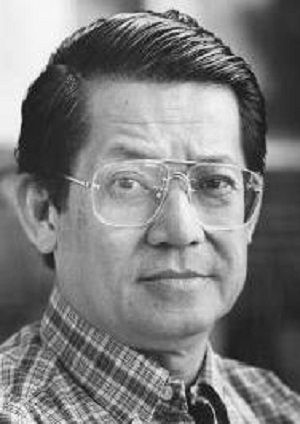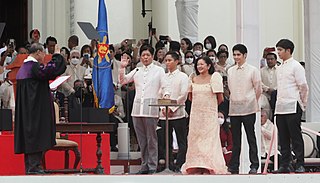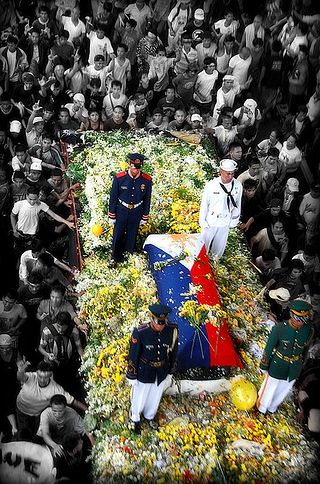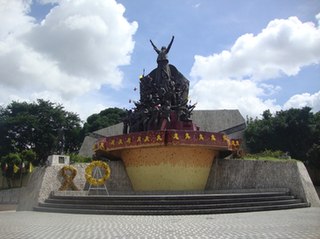
Maria Corazon "Cory" Sumulong Cojuangco-Aquino was a Filipino politician who served as the eleventh president of the Philippines from 1986 to 1992. She was the most prominent figure of the 1986 People Power Revolution, which ended the two-decade rule of President Ferdinand Marcos and led to the establishment of the current democratic Fifth Philippine Republic.

Benigno "Ninoy" SimeonAquino Jr., was a Filipino politician who served as a senator of the Philippines (1967–1972) and governor of the province of Tarlac. Aquino was the husband of Corazon Aquino, who became the 11th president of the Philippines after his assassination, and father of Benigno Aquino III, who became the 15th president of the Philippines. Aquino, together with Gerardo Roxas and Jovito Salonga, helped form the leadership of the opposition towards then President Ferdinand Marcos. He was the significant leader who together with the intellectual leader Sen. Jose W. Diokno led the overall opposition.

Benigno Simeon Aquino III, also known as Noynoy Aquino and colloquially as PNoy, was a Filipino politician who served as the 15th president of the Philippines from 2010 to 2016. The son of assassinated politician Benigno Aquino Jr. and 11th president Corazon Aquino, he was a fourth-generation politician as part of the Aquino family of Tarlac.

The People Power Revolution, also known as the EDSA Revolution or the February Revolution, was a series of popular demonstrations in the Philippines, mostly in Metro Manila, from February 22 to 25, 1986. There was a sustained campaign of civil resistance against regime violence and electoral fraud. The nonviolent revolution led to the departure of Ferdinand Marcos, the end of his 20-year dictatorship and the restoration of democracy in the Philippines.

Jaime Lachica Sin, commonly and formally known as Jaime Cardinal Sin, was the 30th Roman Catholic Archbishop of Manila and the third cardinal from the Philippines. He was instrumental in the historic and peaceful 1986 People Power Revolution, which toppled the dictatorship and ended martial law under Ferdinand Marcos and installed Corazon Aquino as his successor in the Fifth Republic of the Philippines. He was also a key figure in the 2001 EDSA Revolution that replaced President Joseph Estrada with Gloria Macapagal Arroyo.
Teodoro "Teddy" Benigno, Jr. was a leading Filipino journalist with a career spanning seven decades. His writings first graced the print media in 1946, when he joined the Manila Tribune as a sportswriter and police beat reporter. However, the greater part of his career was spent with the Agence France Presse, which he joined as a senior editor in 1950. He would spend 37 years with the AFP, serving as Manila bureau chief from 1962 until 1987. Benigno maintained extensive ties with France. Fluent in French, he studied at the Institut des Sciences Politiques and was awarded the French Legion of Honor in 1989.
2005 in the Philippines details events of note that happened in the Philippines in the year 2005.
2006 in the Philippines details events of note that happened in the Philippines in the year 2006.
A national hero of the Philippines is a Filipino who has been recognized as a national hero for their role in the history of the Philippines. Loosely, the term may refer to all Spanish historical figures recognized as heroes, but the term more strictly refers to those officially designated as such. In 1995 the Philippine National Heroes Committee officially recommended several people for the designation, but this was not acted upon. As of 2023, no one had ever been officially recognized as a Philippine national hero.
Chavit, also known as Chavit Singson Story and Chavit: Blood Son of Ilocos, is a 2003 Filipino biographical drama film produced and directed by Carlo J. Caparas and starring Cesar Montano, Eddie Garcia and Dina Bonnevie.

Ceferino "Joker" Paz Arroyo Jr. was a Filipino statesman and key figure in the 1986 EDSA People Power Revolution that ousted dictator Ferdinand Marcos. He was a Congressman for Makati from 1992 to 2001 and Senator from 2001 to 2013. Arroyo received various awards and commendations for his significant contributions to the law profession and public service. Among these are the Philippine Bar Association's Most Distinguished Award for Justice as a "man beholden to no one except to his country" and Senate Resolution No. 100 enacted in the 8th Congress citing his invaluable service to the Filipino people. He was also known for being the thriftiest legislator, earning the title of "Scrooge of Congress", as he only had few staff members without bodyguards and did not use his pork barrel funds. In 2018, Arroyo was identified by the Human Rights Victims' Claims Board as a Motu proprio human rights violations victim of the Martial Law Era.

The Four Day Revolution is a 1988 Australian television film directed by Robert Markowitz and written by David Williamson. The story is about the journey and the love affair of an American foreign correspondent set during the final years of Ferdinand Marcos' dictatorship in the Philippines, from the assassination of Benigno Aquino Jr. in 1983 to the People Power Revolution in 1986, as well as other key events that led to the ouster of Marcos.
2004 in the Philippines details events of note that happened in the Philippines in the year 2004.

The inauguration of the president of the Republic of the Philippines is a ceremony marking the commencement of the six-year term of a president of the Philippines, who is both head of state and head of government. The inauguration is performed on June 30, as mandated by the 1987 Constitution. Under the older 1935 Constitution, the date was December 30, which is also Rizal Day; the last inauguration held on the older date was Ferdinand Marcos' second one on December 30, 1969. The most recent public presidential inauguration ceremony was that of President Bongbong Marcos, who began his six-year term in office on Thursday, June 30, 2022.

Corazon Cojuangco-Aquino, the 11th President of the Philippines, died on August 1, 2009, at the Makati Medical Center in Makati of cardiorespiratory arrest after being in hospital since June 2009, and was first diagnosed with colorectal cancer in 2008.

Benigno "Ninoy" Aquino Jr., a former Philippine senator, was assassinated on Sunday, August 21, 1983, on the tarmac of Manila International Airport. A longtime political opponent of President Ferdinand Marcos, Aquino had just landed in his home country after three years of self-imposed exile in the United States when he was shot in the head while being escorted from an aircraft to a vehicle that was waiting to transport him to prison. Also killed was Rolando Galman who was accused of murdering Aquino.

The People Power Monument is an 18 m (59 ft)-high monument built to commemorate the events of the 1986 People Power Revolution. The monument is located on the corner of Epifanio de los Santos Avenue and White Plains Avenue in Barangay Camp Aguinaldo, Quezon City, Philippines. It was made by Eduardo Castrillo in 1993. It is about 0.90 kilometers (0.56 mi) from the EDSA Shrine, another monument built to commemorate the event.
The Aquino family of Tarlac is one of the most prominent families in the Philippines because of their involvement in politics. Some family members are also involved in other fields such as business and entertainment.

Napoleon "Nap" Genson Rama, PLH was a Filipino Visayan lawyer, journalist, and writer in English and Spanish from Cebu, Philippines. He was the Vice President of the 1971 Constitutional Convention and the Floor Leader of the 1986 Constitutional Commission. In 2011, he was awarded the Philippine Legion of Honor, the country's highest recognition, with the rank of Grand Commander on the 25th anniversary of the EDSA 1 Revolution by President Benigno S. Aquino III.
Rigoberto "Bobi" Dikit Tiglao is a Filipino activist and opinion columnist.











